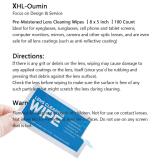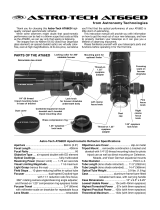
13
CARBON FIBER SERIES
UNPACKING and MOVING
Please Note: We recommend that you keep the original shipping box and packing
materials if possible, in case your scope should ever need to be returned for service or
warranty purposes. Each model in this series comes packed in a deluxe case with spring-
loaded butterfly latches and handles on both ends. After twisting all four latches open,
you will be able to fully remove the lid to reveal the molded interior that includes specific
spaces for all included accessories. When the case is opened for the first time, you will
find that all parts are packaged in plastic bags and the telescope’s tube is wrapped in
tissue. To begin assembly, slowly remove the optical tube from its foam casing. The
102mm, 127mm and 152mm models will all come with their cradle rings attached,
which makes for easy removal. Rarely, the cradle could have come open during packing
or shipping, so it is important to check the latches and then do a quick, small lift by the
cradle handle to make sure the ring is secure before pulling the instrument all the way
out. Although our telescopes are designed with portability in mind, it is important to
use proper lifting techniques to prevent back injury and/or strained muscles. Whenever
possible, use two people to
move or lift the equipment and make use of wheeled devices like carts or dollies for
additional aid. Due to its necessary size and weight, the 152mm model’s case comes with
wheels for easier transport.
DEW SHIELD
The dew shield is an important part of your telescope because it slows moisture build-
up on the objective lens and can reduce image interference caused by ambient light. We
advise using the dew shield when possible to maximize these crucial benefits. For the
80mm, 102mm and 127mm models, the dew shield is an easy-to-operate retractable
style that slides smoothly up and down the optical tube assembly with no installation
required. On the 152mm model, the dew shield is s
tationary and must be attached using
the included set screws. To do this, remove the optical tube assembly from its case, take
off the front dust cover and gently slide off the dew shield, which is in a reverse position
during storage. During packaging, a foam padding is placed between the tube and the
dew shield. This can now be removed. Flip the dew shield around, reattach it to the front
of the tube and secure it by carefully tightening the three set screws. During breakdown,
simply reverse the process.
DIAGONAL
Astronomical observation usually requires the telescope to tilt up significantly, which can
make straight-thru viewing awkward and uncomfortable. A diagonal solves this comfort
problem by using a mirror to direct the light at a 90° angle toward the eyepiece, which is
positioned perpendicular to the OTA making the image more accessible. Equipped to fit
both 1.25” and 2” eyepieces, your telescope’s diagonal houses a precision-polished, two-
begin by removing the dust covers from the focuser’s drawtube and the diagonal itself.
Loosen the screws on the drawtube’s tension collar, and slide the barrel of the diagonal
into the drawtube. Tighten the three tension screws to secure it firmly. Should one of
these tension screws accidentally become loose, the barrel of the diagonal is tapered to
prevent it from falling out of the focuser. The 1.25” eyepiece adapter or 2” eyepieces can
be secured in the diagonal by tightening the tension screws on the compression ring lock.



























